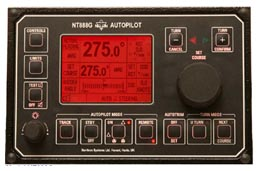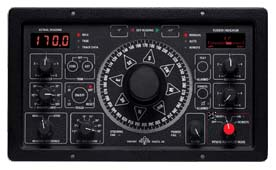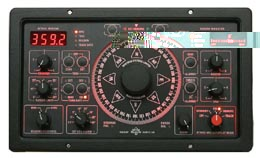Autopilot SIMRAD ROBERTSON AP9 MK3

The Simrad AP9 MK3 Autopilot is suitable for a wide range of vessels, tested and approved according to the latest IMO resolution. The AP9 MK3 autopilot is recognized as the most flexible and adaptable autopilot on the market place.
The list below highlights a few of the features available in this sophisticated autopilot:
- Excellent steering performance
- Two complete sets of pre-programmable steering parameters
- Simple operation by dedicated push-buttons
- Any combination of dual compass input
- Interface to virtually any type of steering gear
- Combined steering and navigation
- Thruster control
As a retrofit model, the AP9 MK3 should be a first choice because of its ability to interface to almost any magnetic or gyrocompass, steering gear and navigation receiver. The possibility of adding a full function second station further emphasizes the capabilities built into AP9 MK3 autopilot system.
The AP9 MK3 has been designed to produce very accurate steering under autopilot control. The autopilot has been programmed to learn how the rudder responds to commands. This both reduces rudder activity and ensures that the rudder is positioned exactly as required, so eliminating rudder overshoot. It also compensates for wear and play in the steering gear, which can be of particular importance when using AP9 MK3 as a retrofit autopilot. Precise course keeping is guaranteed by the ability to set all parameters on the AP9 MK3 individually with a high level of fine tuning. Special rate of turn functions ensure that all vessels, irrespective for their individual steering characteristics can achieve smooth course changes.
The combination of touch buttons, LCD displays and the advanced electronic programming produces efficient operation. All mode selection and steering parameter settings are made using touch buttons and instruction is confirmed on the display. Course changes can be made by the traditional rotary course selector or using 2 push buttons. These produce an exact 1° course change (port/stbd). Vessel heading information is shown digitally, deviation from set course and confirmation of rudder commands are also displayed.
As an optional feature, the AP9 MK3 can be configured to control a bow thruster. Rudders are inefficient at the slow speeds often required by fishing boats, dredgers and survey vessels. A vessel can, however, maintain an accurate heading by automatic control of a bow thruster through the AP9 MK3 autopilot.
The AP9 MK3 can accept information from navigation receivers and plotters to combine steering and validation. In practical terms the autopilot uses constantly updated information to steer the vessel along a predetermined track. The autopilot maintains a straight line between waypoints, reducing or eliminating Cross track error (XTE), and reducing both time and fuel. Ships having navigation equipment with the ability to plan long distance routes (ECDIS) will benefit from fully automatic sailing.
Specification:
| Steering System Types: | Hydraulic, solenenoid control |
| Mains Voltage: | 24 VDC |
| Power Consumption: | dependent of system configuration |
| Protection:
Control unit: Distribution unit: Other units:
|
IP44 IP22 IP56
|
| Rudder unit: | Solid state with adaptive rudder loop |
| Interface: | NMEA-0183 |
| Heading sensors:
Standard: Options:
|
Magnetic compass course detector Gyrocompass interface Fluxgate compass (sin/cos)
|
| Alarms: | Audible and visual, ready for external |
| Language selection: | English, French, Spanish, Norwegian |
| Temperature:
Operating: Rudder feedback and Course detector Storage:
|
0 – 55°C -10 – +55°C -30 – +80°C
|
| Auxiliary equipment:
NFU and Follow-up levers with mode selection Multifunction handheld remote Rudder angle indicator
|
|
| Control Unit: | |
| Connections: | 5 ea AMP-type |
| Displays: | Backlit LCD Course dsplay and bargraph
Backlit LCD Information display
|
| Weight: | 3 kg |
| Distribution Unit: | |
| Mains voltage: | 24 VDC |
| Steering gear interface:
D90 D91 D92 D93 Optional:
|
single 24-40 VDC 3 Amp solid state single 110 VDC 1 Amp solid state single 110/220 VDC 1 Amp solid state dual +/-10 V or 4-20 mA single +/-10 V or 4-20 mA isolated analogue output
|
| Weight: | 4.5 kg |
| Dimensions: | 300 x 320 x 105 mm |
Navitron NT888G

Designed and developed by Navitron Systems Ltd for professional use on Magnetic and/or Gyro based vessels of all types – including High Speed Craft (HSC) – to approximately 3000 gross tones, the Navitron NT888G is a technologically advanced and powerfully equipped Autopilot which is clearly displayed and simple to operate.
Equally at home in new build and retrofit applications over an exceptionally wide range (fishing vessels, tugs, dredgers, ferries, coasters, survey and support units etc.) the NT888G Autopilot offers traditional Navitron reliability reinforced by Adaptive control technology. The adaptive function automatically monitors and self tunes the Autopilot parameters to provide optimum steering performance whether operating on a fishing vessel in a low speed work mode or on a high speed passenger ferry underway at 50 knots.
With a standard scope of supply comprising NT888G Control Unit suitable for foot bracket or panel mounting, robust Rudder Reference Unit and central Distribution Unit, the Autopilot System is immediately compatible with a wide range of vessel steering configurations including single and dual solenoid systems and voltage (±10Vdc) or current driven (4-20mA) Steering Amplifiers.
Up to a maximum of 3 Control Units may be installed per system and each Control Unit is equally equipped with comprehensive displays of Actual Operating Mode, Heading, Rudder Angle, Rate of Turn and Speed Data which is enhanced by Track Steering graphics when the Track Mode is engaged.
The display mode itself (light characters on a dark background or vice versa) is also installation selectable with operator adjustable red backlight illumination to suit individual preference.
Track Mode operation provides single or multi waypoint steering performance based on data received from a proprietary ECDIS/Plotter including – when used in conjunction with an Approved ECDIS – remotely instructed constant radius turns etc.
Other standard features provide “Next Course”, “U Turn” and permanent Heading changes in 1°/ 5°/10° steps etc.
Standard outputs produce NMEA, Furuno and Step by Step heading data for Radar stabilisation etc. and optional equipment includes Power Steer Controls, Analogue / Digital Heading Repeaters and Rudder Indicators.
Specification:
|
Supply Voltage:
|
11-40 VDC |
| Power Consumption: Operation Illumination Max |
10 W 2 W |
| Mag Heading Input Port: | |
| Navitron HSC etc.: | Coil Type HSC 1 or HSC 2 |
| Resolution: | 0,25° |
| Gyro / Mag heading Input Ports (2 Channels): | |
| Mag NMEA 0183: | XX HDM XX HDG XX HCC XX HDT |
| Gyro NMEA 0183: | XX HDT XX HDM XX HDG XX HCC |
| Baud rate: | 4800 / 38400 selectable |
| Resolution: | 0,1° |
| Follow Up Rate (minimum): | 30°/Sec |
| NMEA Speed or Pulse Input Data: | |
| SOG: | $XX VBW $XX VTG |
| STW: | $XX VBW $XX VHW |
| 200/400 ppNm: | 5-24Vp/p (STW in only) |
| Draft Input Data: | |
| Analogue: | 4 – 20mA |
| Track Steer Data Input Ports (TCS): | |
| NMEA 0183 Track Data from Track Control System (Priority as shown): | $XX HTC $XX APB $XX HSC |
| NMEA 0183 Heading Data output (Isolated RS422): | |
| Update Rate (Channel 1): | Selectable @ 1Hz, 10Hz, 20Hz, 40Hz or 50Hz |
| Sentence Types @ 1Hz: Mag Gyro |
$HCHDM, $HCHDG, $APHDM, $APHDG $HEHDT, $AGHDT, $HETHS, $AGTHS |
| Sentence Types @ 10Hz: Mag Gyro |
$HCHDM (5Hz), $HCHDG $HEHDT, $HETHS |
| Sentence Types @ 20Hz: Mag Gyro |
$HCHDM $HEHDT |
| Sentence Types @ 40Hz: Mag Gyro |
$HCHDG $HEHDT |
| Sentence Types @ 50Hz: Mag Gyro |
$HCHDG $HETHS |
| Resolution: | 0,1° |
| Sentence Types @ 10Hz (Channel 2): Mag Gyro |
$APROR, $APTRC $AGROR, $AGTRC |
| Autopilot Status Data @ 1Hz: Mag Gyro |
$APRSA, $APHTD $AGRSA, $AGHTD |
| Furuno Heading Data: | |
| Update Rate: | 5 Hz or 40 Hz |
| Resolution: | 0,166° or 0,1° |
| Signal Amplitude: | Isolated 5Vdc (RS422 / 485) |
| Output: | 20mA Max |
| Step by Step Heading Data: | |
| Steps per Degree: | Selectable @ 3, 6, 12 or 14 |
| Signal Amplitude: | 5 VDC |
| Maximum Rate: | Selectable @ 8, 16 or 24°/Sec |
| Z out: | 470R |
| Analogue outputs: | |
| Dual 4 – 20mA: | Max Voltage / Load Res,. 20Vdc / 1K |
| Dual Solid State Solenoid Switching: | |
| Polarity: | +VE/-VE |
| Max Rating: | 5A @ 11 – 110VDC Max |
| Compass Safe Distance: Control Unit Distribution Unit |
0,5 m 1,5 m |
| Operating Temperature: | -20° to +60°C |
| System Alarms: | Main Power fail Back Up Power Fail Heading Data Fail Track Data Fail Steering Fail Dist Unit Fail Rudder Ref Unit Fail Limit Switch Status CCA Data Fail Watch Alarm Timeout OHA Limit CCA Limit Course Change Track Heading Change Dodge Limit Custom Limit Remote Control Engaged Control Unit Fail |
| Dimensions: Control Unit Dist Unit |
204 × 132 × 48,4 mm 300 × 300 × 120 mm |
| Weight: Control Unit Dist Unit |
1,8 kg 9,5 kg |
Navitron NT921G

Purpose designed by Navitron Systems Limited for professional use on Magnetic and/or Gyro based commercial vessels of all types to approximately 2000 gross registered tonnes, the Navitron NT921G is a powerfully equipped and technologically advanced Autopilot which remains simple to operate.
Equally at home in new build and retrofit applications over an exceptionally wide range (fishing vessels, tugs, dredgers, ferries, coasters, survey and support units etc.) the NT921G Autopilot offers traditional Navitron performance and reliability reinforced by RMRS type approval to IMO and ISO standards.
Comprehensively intelligent, standard features of the NT921G Control Unit include a built in Radio Navigator interface, Dual Mag and Gyro Heading Inputs, Heading Outputs for Radar Stabilisation/Nav Computer use etc, fully Automatic Stability Compensation to accommodate Two Speed Rudder Systems and programmable Rate Of Turn.
- Full P.I.D Intelligence.
- Servo drive Heading Repeater (Standby mode).
- AutoTrim (Automatic Permanent Helm).
- Digital Heading and Cross Track Error display.
- Bargraph and digital Rudder Angle display.
- Operator variable control panel illumination.
- 11 – 40Vdc Power Supply compatible.
- Solid State Output stages (5A max).
- Fully programmable installation parameters.
Specification:
|
Supply Voltage Range:
|
11-40 VDC |
|
Power Consumption (@24Vdc):
Operation Illumination Max |
2.5 W 8.1 W |
| Mag Heading Input Ports: | |
|
Navitron Heading Sensor Coil mounted above/below Existing Mag Compass:
|
Coil type HSC1 or HSC2 |
| Resolution: | 0.25° |
| NMEA 0183 Heading Sentence from Electronic Compass (Priority as shown): | XX HDM, XX HDG, XX HCC, XX HDT |
| Resolution: | 0.1° |
| Gyro Heading Input Ports: | |
| Isolated 1:1 Synchro available in Gyro: | 400Hz Excitation from Autopilot |
| Resolution: | 0.25° |
| NMEA 0183 Heading Sentence from Gyro (Priority as shown): | XX HDT ,XX HDM, XX HDG, XX HCC |
| Resolution: | 0.1° |
| Follow Up Rate (Minimum): | 30° / Sec |
| Cross Track Error Signal Input (GPS etc): | |
| NMEA 0183 Sentence types | XX APA, XX APB, XX RMB, XX XTE |
| NMEA 0180: | (CTE only) |
| Operating Temperature Range: | -20° to +60°C |
| NMEA 0183 (Isolated RS422) output: | |
| Update Rate: | Selectable @ 1Hz, 11Hz or 22Hz |
| Sentence types @1Hz: Mag Gyro |
HCHCC, HCHDG , APHCC, APHDG HEHDT, AGHDT |
| Sentence types @11Hz: Mag Gyro |
HCHDM, HCHDG HEHDT, ADHDT |
| Sentence types @22Hz: Mag Gyro |
HCHDM HEHDT |
| Resolution: | 0.1° |
| Furuno Format output: | |
| Update Rate: | Selectable @ 5Hz or 40Hz |
| Resolution: | Selectable @ 0.166° or 0.1° |
| Signal Amplitude: | Selectable @ 5VDC or 12VDC |
| Step by Step: | |
| Steps per Degree: | Selectable @ 3, 6,12 or 24 |
| Signal Amplitude: | 5 VDC |
| Solenoid Switching: | |
| Polarity: | Selectable Common +VE/-VE |
| Max Rating: | 5A @ 40VDC |
| Panel Alarms: | Power Fail Steering System Fail Heading Input Fail Data Input Fail Off Course Remote Engaged Alarm Test Facility |
Navitron NT991G MK2

Designed and developed by Navitron Systems Ltd for commercially operated ocean going vessels of all types from typically 1800 gross registered tones upwards, the Navitron NT991G MK2 Autopilot is fully type approved to latest IMO and ISO standards.
Available in various system configurations the NT991G MK2 can be supplied for immediate compatibility with most gyro compass and steering system types rendering it an extremely cost effective solution for new build and retrofit installations. Additionally, the NT991G MK2 Autopilot features automatic Waypoint Steering based on “Heading to Steer” serial data received from proprietary Track Plotters/ECDIS systems etc. ($HTC, $HSC, $APB sentences).
Comprehensively intelligent, other standard features include Dual Mag and Gyro Heading Inputs, serial data outputs for Radar Stabilisation / Nav Computer / VDR use etc, fully Automatic Stability Compensation to accommodate Two Speed Rudder Systems and programmable Rate of Turn in degrees per minute.
Simple to operate via a traditional and clearly marked rotary Course Setter, the NT991G MK2 is immediately compatible with existing Navitron equipment including Watch Alarms, Heading Repeaters, Rudder Angle Indicators and Power Steer Controls.
- Full P.I.D Intelligence.
- Servo Drive Heading Repeater (Standby mode).
- AutoTrim (Automatic Permanent Helm).
- Digital Heading and ROT data display.
- Bargraph and digital Rudder Angle display.
- Operator variable control panel illumination.
- 11 – 40Vdc Power Supply compatible.
- Solid State Output stages ( 11 – 40 Vdc / 5A max.)
- Fully programmable installation parameters.
Specification:
|
Supply Voltage:
|
11-40 V DC |
| Power Consumption (@24VDC): Operating Illumination Max |
2.5 W 8.1 W |
| Mag Heading Input Ports: | |
| Navitron Heading Sensor Coil mounted above/below Existing Mag Compass: | Coil type HSC1 or HSC2 |
| Resolution: | 0.25° |
| NMEA 0183 Heading Sentence from Electronic Compass (Priority as shown): | XX HDM XX HDG XX HCC XX HDT |
| Resolution: | 0.1° |
| Gyro Heading Input Ports: | |
| Isolated 1:1 Synchro: | 400Hz Excitation from Autopilot |
| Resolution: | 0.25° |
| NMEA 0183 Heading Sentence from Gyro (Priority as shown): | XX HDT XX HDM XX HDG XX HCC |
| Resolution: | 0.1° |
| Track Data: | XXHTC, XXHSC, XXAPB |
| Follow Up Rate (Minimum): | 30°/Sec |
| Output NMEA 0183 (Isolated RS422): | |
| Update Rate: | Selectable @ 1Hz, 10Hz or 20Hz |
| Heading Sentence types @ 1Hz: Mag Compass Gyro |
HCHCC, HCHDG, APHCC, APHDG HEHDT, AGHDT |
| Heading Sentence types @ 10Hz: Mag Compass Gyro |
HCHDM (5Hz), HCHDG HEHDT, ADHDT (5 Hz) |
| Heading Sentence types @ 20Hz: Mag Compass Gyro |
HCHDM HEHDT |
| Resolution: | 0.1° |
| Autopilot Status Data @ 1Hz: Mag Compass Gyro |
APRSA, APHTD AGRSA, AGHTD |
| Furuno Format: | |
| Update Rate: | Selectable @ 5Hz or 40Hz |
| Resolution: | Selectable @ 0.166° or 0.1° |
| Signal Amplitude: | 5VDC or 12VDC |
| Step by Step: | |
| Steps per Degree: | 3, 6,12 or 24 |
| Signal Amplitude: | 5 VDC |
| Navitron Serial Data To Navitron Digital Repeaters Etc: | |
| Polarity: | +VE/-VE |
| Max Rating: | 5A @ 40VDC |
| Compass Safe Distance: | 0.6 m |
| Operating Temperature: | -20° to +60°C |
| Panel Alarms: | Power fail Steering System Fail Heading Input Fail Alarm Test facility Off Course Rudder Limit Turn Rate Limit Remote Engaged |
| Operator Controls: | Yaw Rudder Counter Rudder Rudder Limit Turn Rate Illumination Mode Switch Off Course Alarm Gyro/Mag Selector Auto Trim |
| Control Unit dimensions: | 297 × 176 × 110 mm |
| Control Unit weight: | 3.3 kg |
Yokogawa PT500
The PT500 Series autopilot conforms to the technical requirements for the performance It is available in two versions. The PT500A – Adaptive and the PT500D – Digital Autopilot, which differ in the respect of the method of auto steering. You can freely select a suitable model and configure the optimum system for the type of vessel concerned.
The Steering Stand design is suitable for standing or sitting positions based on the ergonomic principles of height (1124 mm). A separate unit is used for each purpose allowing for excellent functional expandability and operability. However, all components within the stand can easily be incorporated into a panel and cockpit bridge console due to their compact design which is about 80% smaller when compared with our previous models.
In addition to the independent follow-up circuit, the automatic and hand steering control systems are also independent of each other. The function keys are easy to use and understand with pictorial characters for every function to help reduce the possibility of an incorrect/accidental command.
Configuration of Autopilot System:
The autopilot system is configured with the following basic components.
1) Control Stand
consists of the following units, which are also adequate to the panel-mount.
– Auto unit
– Annunciator unit
– Hand steering unit
– Switch units
2) Control Power Supply Box
3) “м”-Transmitters
4) Actuators (Supplied and handled by the steering gear manufacturer)

Control Methods:

Autopilot control methods are categorized as follow up (FU) control and the non-follow-up (NFU) control.
- Follow up (FU) control
This is servo control which drives the rudder until the command angle of the autopilot is equals to the feedback angle from the steering gear. FU control is divided into automatic steering (AUTO) mode, manual steering (HAND) mode, remote control (RC) mode, and NAVI mode, which is especially provided for track control. These modes can be selected with the MODE switch.
- Non-follow-up (NFU) control
This is open loop control and it is occasionally used in emergencies. It directly drives the actuators of the steering gear. This control is well known as emergency steering and selectable when SYSTEM switch is in the NFU position.
Steering Modes:
- NAVI mode (FU Steering)
This mode enables track control. Interface with INS equipment such as ECDIS is required. - AUTO mode (FU Steering)
This mode automatically keeps the ship’s heading to a preset course. A heading reference signal from a gyrocompass is required. - HAND mode (FU Steering)
This mode manually controls ship’s heading from the steering wheel on the front of control stand. Number of potentiometers mechanized in the steering wheel can be provided in coincidence with the number of steering control chains. - RC mode (FU Steering)
This mode manually controls the ship’s heading, and the control can be done away from the control stand. A dial remote controller or the like is required. - NFU steering
This mode directly drives the actuators of the steering gear. The rudder is driven when the lever switch is moved to port or starboard, and stops moving when the lever switch is in neutral.

Explanation of Units:
- PB343 Auto-steering Unit (Adaptive auto unit),
PB344 Auto-steering Unit (PID auto unit)
These units are used in AUTO mode. The AUTO mode contains following controls:
– Adaptive control (PB343), and
– PID control (PB344).
Each of the above models are customized to suite each vessel’s specifications.
- PB345 Auto-steering Unit (PID auto unit : Optional)
This unit is the same as PB344 but is designed for longitudinal mounting.
- PB335 Hand-steering Unit
This unit uses hand steering in HAND mode. Steering angle and direction indicators are positioned alongside the wheel.
- PT161 Dial Steering Unit (Optional)
The unit is remote controller used in RC mode.
- MKR051 Steering Repeater Compass
This unit is a ship’s heading repeater for use by the helmsman, and dimming control is available. This unit is suitable for panel-mounting or wall-mounting.
- PH614 Annunciator Unit
This unit displays the operating status of the autopilot and issues visible and audible alarms when a failure occurs. Repertoire of display is provided by accordance with the specification requirements of the autopilot.
- PH718 Switch Unit (SYSTEM switch)
This unit consists of two switches arranged on a single panel. The first switch selects follow up control chains (FU1 or FU2) or non-follow-up (NFU) control chains to be used, and the second switch is on the non-follow-up (NFU) lever. The NFU lever is functional when NFU control is selected.
- RH720 Switch Unit (MODE switch)
This unit is the steering mode selector. This unit is provided in accordance with the specifications of the autopilot.
- PH721 Switch Unit
The unit is used when two auto-steering units are employed. There are two types of switches as follows depending on the system.
– ADAP/PID switch
– PID1/PID2 switch
Specification:
| Power: | |
| Main Power: | 220/380/440AC ±20%, 50/60Hz ±1 or 3 Phase 700 VA |
| Enunciator:: | 24VDC |
| Input Signal: | |
| Speed Signal PT500A for Adaptive Control & PT500D for the lower speed band control (optional) | |
| Pulse signal: | 200PPNM |
| Output Circuit: | Photo Coupler 5VDC @ 2mA |
| Gyrocompass Heading Signal: | |
| Serial Signal: | NMEA-0183 ASYNC Serial Data |
| Baud Rate: | 1200/2400/4800/9600 |
| Output Interval: | 100ms ~ 20s (100ms Interval) |
| Data Format: | Start 1 bit, Data 7/8 bits, Stop Ѕ bits, Parity none/odd/even |
| Header: | 5 ACSII Letter |
| Position data: | Set data based on the location of commas. |
| Checksum: | Yes or No |
| Output Signal: | |
| Course deviation/rudder angle/rate of turn steering mode signal | |
| Serial Signal: | NMEA-0183 ASYNC Serial Data |
| External Devices: | INS, ECDIS |
| Baud Rate: | 2400/4800 |
| Output Interval: | 1 Second |
| Data Form: | Start 1 bit, Data 8 bit, Stop 2 bits, Parity none |
| Output Circuit: | EIA RS422A |
| Checksum: | Checksum is the exclusive – OR between “$” and before the “*”/ The hex value of the result are converted to ASCII characters. |
| Analog rudder angle signal | |
| External Device: | Courser Recorder |
| Signal Level: | 0 ~ 5VDC |
| Analog course Deviation Signal | |
| Signal Level: | 0 ~ 5VDC |
| Ripple Level: | 5mVpp |
| Accuracy of output voltage: | ±5% |
| No Voltage Alarm Contact Signal | |
| Contact Rating: | 125VAC @ 1Amp |
| System Failure Alarm Contact Signal | |
| Contact Rating: | 125VAC @ 1Amp |
| Performance Specification | |
| Accuracy of course keeping: | < ±1° |
| Withstanding Voltage: | 1500VAC for 1 Minute |
| Insulation resistance: | > 10Ohms |
| Power Value: | > 500VA |
| Environmental Conditions | |
| Voltage: | 20~30VDC |
| Temperature: | 0~55°C |
| Humidity: | 0~95% RH |
| Vibration: 2.0~13.2Hz 13.2~100Hz |
2 mm 0.75 mm |
| Shock: | 6 Direction, 20G, 10 mseconds |
| Inclination: | ± 22.5° |
| Swaying: | ± 22.5° |
| With standing water: | IP55 (Front Panel) |